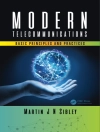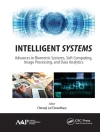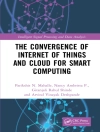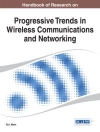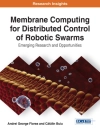This book studies the simulation of wireless networking in the domain of Intelligent Transportation Systems (ITS) involving aircraft, railway and vehicular communication. On this subject, particular focus is placed on effective communication channels, mobility modeling, multi-technology simulation and global ITS simulation frameworks.
Networking Simulation for Intelligent Transportation Systems addresses the mixing of IEEE802.11p and LTE into a dedicated simulation environment as well as the links between ITS and Io T; aeronautical mobility and VHD Data Link (VDL) simulation; virtual co-simulation for railway communication and control-command; realistic channel simulation, mobility modeling and autonomic simulation for VANET and quality metrics for VANET.
The authors intend for this book to be as useful as possible to the reader as they provide examples of methods and tools for running realistic and reliable simulations in the domain of communications for ITS.
Innehållsförteckning
Preface xi
Chapter 1 Simulation of Convergent Networks for Intelligent Transport Systems with VSim RTI 1
Robert PROTZMANN, Björn SCHÜNEMANN and Ilja RADUSCH
1.1 Introduction 1
1.2 Fundamentals of cooperative ITS 2
1.2.1 Message types 2
1.2.2 Application categories 3
1.2.3 Supporting facilities 4
1.3 Overall simulation framework 5
1.4 Simulation of cellular networks 6
1.4.1 Regions and cells 10
1.4.2 Delay models 11
1.4.3 PR-Model and PL-Model 12
1.4.4 Capacity Model 13
1.4.5 Topological and geographical messaging 14
1.5 Simulation study 14
1.5.1 Evaluation metrics 16
1.5.2 Simulation set-up 18
1.5.3 Simulation results 21
1.6 Conclusion 25
1.7 Bibliography 26
Chapter 2 Near-field Wireless Communications and their Role in Next Generation Transport Infrastructures: an Overview of Modelling Techniques 29
Christian PINEDO, Marina AGUADO, Lara RODRIGUEZ, Iñigo ADIN, Jaizki MENDIZABAL and Guillermo BISTUÉ
2.1 Near-field wireless technologies 30
2.1.1 Near-field versus far-field 30
2.1.2 Near-field-based technologies in transport 33
2.2 Characterization of near-field communications 36
2.2.1 Electrical models 37
2.2.2 Analysis of the mutual inductance of a squared inductive coupling 37
2.2.3 Computer-aided electromagnetic calculation 40
2.3 Discrete event simulators 42
2.3.1 Riverbed Modeler 43
2.3.2 OMNe T++ 44
2.3.3 ns-2 45
2.3.4 ns-3 45
2.3.5 Discrete event simulator comparison for near-field communication 46
2.4 Conclusions 47
2.5 Bibliography 48
Chapter 3 Trace Extraction for Mobility in Civil Aeronautical Communication Networks Simulation 51
Fabien GARCIA and Mickaël ROYER
3.1 Traffic regulations 52
3.1.1 General airspace 52
3.1.2 North Atlantic airspace 53
3.2 Mobility for network simulation 54
3.2.1 Types of mobility models for AANETs 54
3.2.2 Comparison of mobility model types 55
3.3 Example of mobility trace extraction 56
3.3.1 Extraction of information 57
3.3.2 Traces filtering 57
3.3.3 Enhancing traces 58
3.4 Toward cooperative trajectories 60
3.5 Bibliography 60
Chapter 4 Air-Ground Data Link Communications in Air Transport 61
Christophe GUERBER, Alain PIROVANO and José RADZIK
4.1 Introduction 61
4.1.1 Context 61
4.1.2 OMNe T++ 63
4.2 Continental air-ground data link communications and VDL mode 2 63
4.2.1 Communication system 63
4.2.2 Dimensioning parameters and bottlenecks 65
4.2.3 Simulation model 67
4.2.4 Analysis of simulation results 69
4.3 Oceanic air-ground data link communications and AMS(R)S 71
4.3.1 The aeronautical mobile satellite (route) service and Classic Aero 71
4.3.2 Dimensioning parameters and bottlenecks 73
4.3.3 Simulation model 74
4.3.4 Analysis of simulation results 75
4.4 Summary and further work 76
4.5 Bibliography 77
Chapter 5 A Virtual Laboratory as an Assessment Tool for Wireless Technologies in Railway Systems 79
Patrick SONDI, Eric RAMAT and Marion BERBINEAU
5.1 Introduction 80
5.2 ERTMS subsystems and related test beds 81
5.2.1 The functional subsystem of the ERTMS 81
5.2.2 The telecommunication subsystem of the ERTMS 84
5.3 A virtual laboratory based on co-simulation for ERTMS evaluation 86
5.3.1 Why a co-simulation approach? 86
5.3.2 Which data and processes must be modeled in each simulator? 87
5.3.3 Overall architecture of the ERTMS–OPNET virtual laboratory 89
5.3.4 Synchronization modes 90
5.3.5 Virtual laboratory implementations in the ERTMS simulator 92
5.3.6 Virtual laboratory implementations in OPNET 93
5.3.7 Virtual laboratory implementations in the co-simulation manager 95
5.4 Effective use of the ERTMS–OPNET virtual laboratory 97
5.4.1 A co-simulation scenario with the ERTMS–OPNET virtual laboratory 97
5.4.2 Efficiency of the co-simulation approach in the evaluation of railway systems 101
5.5 Conclusion 104
5.6 Bibliography 105
Chapter 6 Emulating a Realistic VANET Channel in Ns-3 107
Hervé BOEGLEN, Benoit HILT and Frédéric DROUHIN
6.1 Introduction 107
6.2 Influence of the channel propagation model on VANET simulation 107
6.2.1 A realistic IEEE802.11 PHY layer 108
6.2.2 Accurate VANET channel propagation modeling 109
6.3 A way to realistic channel modeling with ns-2 112
6.4 Realistic channel modeling with ns-3 114
6.4.1 The Yans Wi Fi model 114
6.4.2 The Physim Wi-Fi model emulating OFDM-based transmission 115
6.4.3 Data transmission at ns-3 PHY level 116
6.4.4 The internals of Wi Fi channel modeling 117
6.5 Case studies: emulation of realistic VANET channel models in ns-3 117
6.5.1 A simplified VANET channel model for an urban environment 118
6.5.2 A normalized VANET channel model for urban environments 121
6.6 Conclusion and discussion 123
6.7 Appendix A: The Abbas et al Model Implementation 125
6.8 Bibliography 130
Chapter 7 CONVAS: Connected Vehicle Assessment System for Realistic Co-simulation of Traffic and Communications 133
Justinian ROSCA, Ines UGALDE, Praprut SONGCHITRUKSA and Srinivasa SUNKARI
7.1 Introduction 133
7.2 Related work 135
7.3 CONVAS co-simulation platform 138
7.4 Realistic DSRC channel models 139
7.4.1 CONVAS propagation models 141
7.4.2 Model tuning based on real-world data 142
7.5 Channel model tuning 143
7.5.1 Michigan safety pilot model deployment data 143
7.5.2 Estimation of PDR 144
7.5.3 Model tuning 146
7.6 Connected vehicle applications 149
7.6.1 Intelligent dilemma zone avoidance 149
7.6.2 IDZA implementation in CONVAS 150
7.6.3 IDZA performance criteria 151
7.7 Experimental results 151
7.7.1 CONVAS setup 151
7.7.2 Co-simulation results 152
7.8 Conclusions 159
7.9 Acknowledgments 160
7.10 Bibliography 161
Chapter 8 Highway Road Traffic Modeling for ITS Simulation 165
Marco GRAMAGLIA, Marco FIORE, Maria CALDERON, Oscar TRULLOLS-CRUCES and Diala NABOULSI
8.1 Introduction 165
8.2 Road traffic models 166
8.2.1 Traffic input feeds 168
8.2.2 Mobility models 169
8.3 Fine-tuned measurement-based model 170
8.4 Comparative analysis of road traffic models 174
8.4.1 Case study scenarios 174
8.4.2 Connectivity metrics 175
8.4.3 Results 176
8.5 Fundamental properties of highway vehicular networks 178
8.6 Discussion and conclusions 181
8.7 Bibliography 182
Chapter 9 F-ETX: A Metric Designed for Vehicular Networks 185
Sébastien BINDEL, Benoit HILT and Serge CHAUMETTE
9.1 Introduction 185
9.2 Link quality estimators 187
9.2.1 Hardware-based LQE 188
9.2.2 Software-based 189
9.2.3 Discussion 190
9.3 Analysis of legacy estimation techniques 190
9.3.1 Type of window 191
9.3.2 Window analysis 193
9.4 The F-ETX metric 195
9.4.1 Window management algorithms 195
9.4.2 Multi-assessment approach 197
9.4.3 Routing integration framework 199
9.5 Simulation settings 201
9.5.1 First scenario 202
9.5.2 Second scenario 202
9.6 Simulation results 202
9.6.1 Performance of the multi-estimators 203
9.6.2 Performance of routing protocols 206
9.7 Conclusion 208
9.8 Bibliography 209
Chapter 10 Autonomic Computing and VANETs: Simulation of a Qo S-based Communication Model 211
Nader MBAREK, Wahabou ABDOU and Benoît DARTIES
10.1 Introduction 211
10.2 Autonomic Computing within VANETs 212
10.2.1 Autonomic Computing 212
10.2.2 Autonomic vehicular communications 213
10.3 Broadcasting protocols for VANETs 213
10.3.1 Deterministic methods 215
10.3.2 Stochastic methods 216
10.4 Autonomic broadcasting within VANETs 218
10.4.1 Optimization of broadcasting protocols in VANETs 218
10.4.2 Self-management architecture 219
10.4.3 Qo S-based broadcasting 221
10.5 Simulation of a Qo S-based communication model 222
10.5.1 ADM: autonomic dissemination method 222
10.5.2 Simulation environment 228
10.5.3 Performance evaluation 229
10.6 Conclusion 231
10.7 Bibliography 232
List of Authors 235
Index 239
Om författaren
Benoit Hilt is Assistant Professor of computer networking at the University of Haute-Alsace, France. His current research focuses on high mobility wireless communication, realistic simulation in the ITS domain and cooperative communication for autonomous driving.
Marion Berbineau is Research Director at IFSTTAR, France in wireless communications for vehicular applications. Her research interests are mainly radio channel characterization and modeling, electromagnetic simulations, signal processing for telecommunications, performance evaluation at physical layers and GNSS applications.
Alexey Vinel is Full Professor in computer communications at Halmstad University, Sweden. His research interests include wireless communications and networking, cooperative intelligent transportation systems and autonomous driving.
Alain Pirovano is Professor at ENAC (French Civil Aviation University) and Head of the Communication Networks Research Group. His research activities focus on routine, reliable, and distributed systems particularly in the context of wireless ad hoc networks and aeronautical networks.


